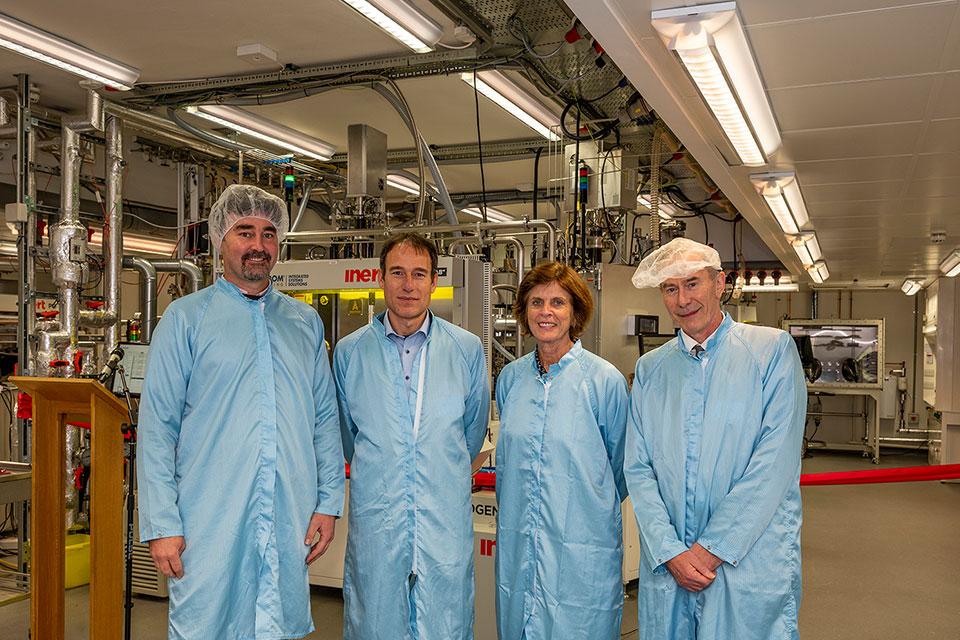A brand new national facility was officially opened last week at Oxford’s Department of Physics. The National Thin-Film Cluster Facility for Advanced Functional Materials (NTCF) provides state-of-the-art vacuum deposition capabilities – the ability to fabricate multilayer structures of incredibly thin materials of this exciting class of materials under highly controlled conditions. The facility will enable research in, and the development of, next generation advanced functional materials for a wide range of applications from functional coatings to optoelectronic devices.
The bespoke cluster tool comprises several interconnected vacuum chambers – rather than existing isolated deposition chambers – allowing for the creation of multilayer structures using a range of different processes and combining materials that cannot done in the same vacuum chamber. The NTCF is key to the UK’s R&D capabilities in the development of next-generation materials and devices for application in energy, photonics and electronics.
The NTCF will be used by researchers across the UK and the facility’s initial focus is on three material groups: perovskites for use in optoelectronics with applications ranging across solar energy, displays and electronic circuits; exploring the potential of organic semiconductors already used in the latest generation of displays for television screens and mobile phones; and research into metal oxides, the transparent electrode used in a variety of devices and with the potential to be used as transistors to drive a new generation of displays.
UK at centre of advanced functional materials R&D
‘This new facility augments and is synergistic to the UK’s world-leading capabilities in solution-processed advanced functional materials and will help to place us at the centre of R&D in the field for commercially viable vacuum deposition techniques,’ comments Professor Moritz Riede who led the project. ‘As a national facility, the NTCF is open to researchers across the country as well as the more than 50-strong community here in Oxford working in advanced functional materials. It is a fast-paced field so we have ensured that the NTCF can be expanded and adapted to meet future research needs. For example, we have recently purchased the first characterisation tool, an ultraviolet photoelectron spectroscopy (UPS) system for the NTCF, which will be commissioned next year, and we can add further process chambers such as for pulsed layer deposition for example and other characterisation techniques.’
The facility allows for unprecedented process control and versatility and has been designed such that all chambers can be used in parallel by several users simultaneously, maximising the potential research output. The NTCF’s initial five thin-film deposition chambers – two organic thermal deposition chambers, one perovskite thermal deposition chamber, one sputter chamber, and a chamber for atomic layer deposition – are connected by handler units that enable transfer-under-vacuum conditions and the various deposition processes enable close control of the thickness (<1 to >100 nanometres) and composition of each layer of the material on substrates up to about 15x15cm².
A national collaboration
The facility, co-directed by Professor Henry Snaith and Professor Riede, is housed in a dedicated laboratory refurbished specifically for this purpose in the Department of Physics. A national collaboration with co-investigators from the Universities of Cambridge and Loughborough and Imperial College London, the facility has been funded by the UK’s EPSRC and the Wolfson Foundation and the University of Oxford.
‘The NTCF bridges academic research and industry research and will enable the development of a broad portfolio of new materials and devices,’ concludes Professor Henry Snaith. ‘One area in particular where the facility could have a transformational impact is energy; new materials, from perovskites to organic semiconductors, have the potential to rival and then exceed conventional inorganic semiconductors opening new doors for photovoltaic, light emission and photonic technologies. It is incredibly exciting to see what the future holds.’
Find out more about the National Thin-film Cluster Facility for Advanced Functional Materials.

